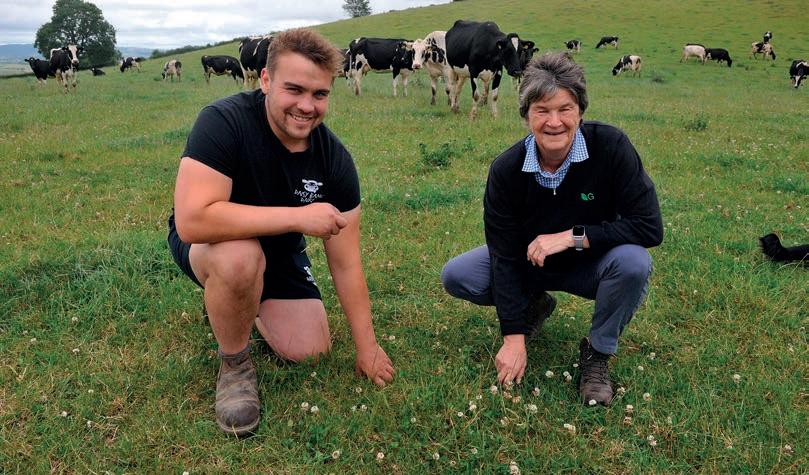
3 minute read
RYEGRASS
Using min-till to establish a multi-species sward in permanent pasture has rejuvenated leys at a Montgomeryshire organic dairy farm, increasing perennial ryegrass in the sward by 30% and boosting white clover content, too. e Lloyd family have been farming organically at Gate Farm,
Llandyssil, since 2015, in a system that maximises milk production from grass. eir herd of 170 Friesian
Holsteins produces an annual average yield of 6,600 litres per cow, with 4,100 of those litres coming from forage.
Ploughing has traditionally been used in the farm’s reseeding programme, but, keen to trial methods that minimise soil disturbance, third-generation farmer Glenn
Lloyd embarked on a Farming
Connect focus farm project to investigate how min-till could be used to increase sward diversity in permanent pasture.
Since the farm is organic, a herbicide cannot be used before seeding and the thick thatch at the base of the 30-year-old sward proved a challenge.
Helen Mathieu, of Germinal, who provided technical input into the project, says old permanent pastures bene t from a herbicide treatment because old grassweeds and grasses need to be killed o to allow room for new perennial ryegrass.
In a system when this cannot be applied, Ms Mathieu says it is important to use the right seed drill for the job.
For the Gate Farm project, a
Gu ler Greenmaster 300 Tined
Seed was used.
Mr Lloyd says it was a ‘tall order’ to overseed permanent pasture with a thick thatch.
“It was a big ask, but it was impressive watching the machine work; it really did rip through the thatch.’’ e eld was overseeded with a mixture of plantain, chicory, red and white clover and perennial ryegrass at the end of July, when conditions were very dry.
Performance the following spring was impressive, says Mr Lloyd.
“Growth in the spring and late autumn has been exceptional.’’
Establishment
It had an opening cover of 3,100kg DM/hectare when it was grazed in late February.
Ryegrass content in the eld, which previously had a high proportion of meadow grass, had been boosted by at least 30%. But there had been poor establishment of herbs and legumes – chicory and plantain content was sparse.
“ e herbs have really struggled with the permanent pasture,’’ says Ms Mathieu.
She says overseeding with herbs would be more successful in four- or ve-year-old pasture. e condition of the pasture, the type of drill used and the prevailing weather conditions are all important factors for overseeding, she adds
“If it is really dry mid-summer and you get good soil-to-seed contact, it is likely to be more successful; herbs and legumes like to be planted in good time, no later than mid-August.’’
Although the results from mintill at Gate Farm had been mixed, Mr Lloyd says the project has given him the con dence to include this technique in his cultivation toolkit going forward.
He says: “It has proved that it is possible, but perhaps the soil needs to be aerated too, to get a be er result.”
Mr Lloyd is also aiming to reduce the farm’s reliance on bought-in feed and, as another Farming Connect project, he grew 4.5ha (11 acres) of brassicas using both conventional and min-till establishment.
He opted for Redstart, a hybrid brassica that grows quickly and vigorously and o ers grazing options from July to around the end of January, depending on sowing date. e crop was grazed with 28 in-calf heifers, each with a daily dry ma er intake requirement of 12kg.
e crop provided 7kg and round bale silage of 5kg.
Ms Mathieu calculates the conventional crop grew 3t DM/ha at 15-18% protein and 12ME at a cost 4p/kg, and extended the grazing season by 70 days.
Although the conventionally established crop grew well, performance was poor in the section of the eld where the min-till technique had been used to plant the seed into permanent pasture.
“I think this project has shown that conventional cultivation is be er for growing brassicas, as they bene t from having a ne, rm and clean seedbed,’’ says Ms Mathieu.
Min-till boosts ryegrass content
Glenn Lloyd and Helen Mathieu. Farm facts
rLand farmed consists of 97 hectares (240 acres) owned and 57ha (141 acres) rented rSoils average 6.5–7 pH and index 3 for P and K rFarm rises from 550-900ft r50% of milk sold to OMSCo and 50% in direct sales through Daisy Bank Dairy r1.3 tonnes of concentrates fed per cow










